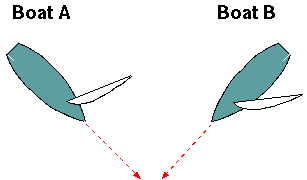astevenson
New Member
Just freshening up on the sailing rules and have a question: my reading is that port and starboard are determined by the side of the boat that the wind is coming over, not the side that the boom is on. Is this right?
Does this mean that if you are on a broad reach on port tack and bear away so that you are now sailing by the lee, you have also switched to starboard tack - even though you have NOT actually gybed?
The follow up question is how that would relate to luffing games on a leg which is square run - the windward boat on port tack bears away to sail by the lee (no gybe, but is then sailing on starboard) and has right of way over downwind port boat. Am I wrong? I am confused.






Does this mean that if you are on a broad reach on port tack and bear away so that you are now sailing by the lee, you have also switched to starboard tack - even though you have NOT actually gybed?
The follow up question is how that would relate to luffing games on a leg which is square run - the windward boat on port tack bears away to sail by the lee (no gybe, but is then sailing on starboard) and has right of way over downwind port boat. Am I wrong? I am confused.







